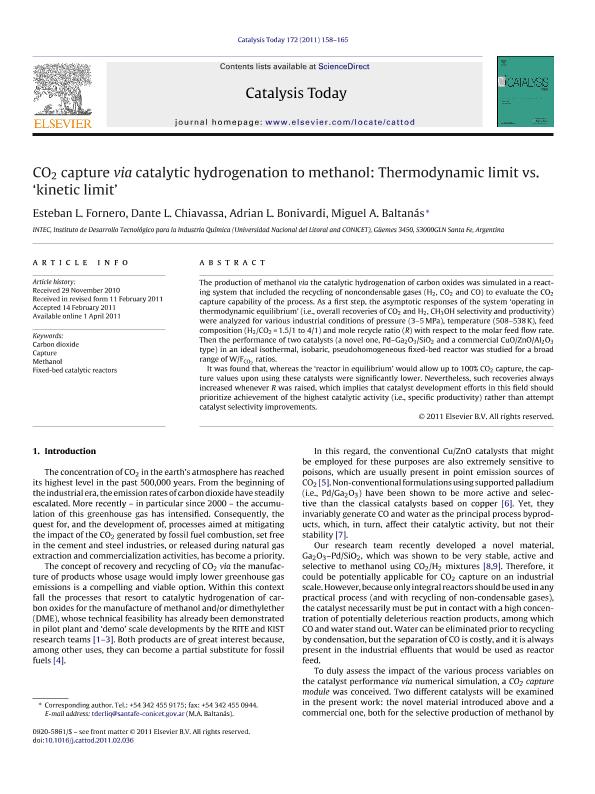Artículo
CO2 capture via catalytic hydrogenation to methanol: Thermodynamic limit vs. 'kinetic limit
Fecha de publicación:
08/2011
Editorial:
Elsevier Science
Revista:
Catalysis Today
ISSN:
0920-5861
Idioma:
Inglés
Tipo de recurso:
Artículo publicado
Clasificación temática:
Resumen
The production of methanol via the catalytic hydrogenation of carbon oxides was simulated in a reacting system that included the recycling of noncondensable gases (H2, CO2 and CO) to evaluate the CO2 capture capability of the process. As a first step, the asymptotic responses of the system 'operating in thermodynamic equilibrium' (i.e., overall recoveries of CO2 and H2, CH3OH selectivity and productivity) were analyzed for various industrial conditions of pressure (3-5 MPa), temperature (508-538 K), feed composition (H 2/CO2 = 1.5/1 to 4/1) and mole recycle ratio (R) with respect to the molar feed flow rate. Then the performance of two catalysts (a novel one, Pd-Ga2O3/SiO2 and a commercial CuO/ZnO/Al2O3 type) in an ideal isothermal, isobaric, pseudohomogeneous fixed-bed reactor was studied for a broad range of W/FCO 2 ratios. It was found that, whereas the 'reactor in equilibrium' would allow up to 100% CO2 capture, the capture values upon using these catalysts were significantly lower. Nevertheless, such recoveries always increased whenever R was raised, which implies that catalyst development efforts in this field should prioritize achievement of the highest catalytic activity (i.e., specific productivity) rather than attempt catalyst selectivity improvements.
Palabras clave:
CAPTURE
,
CARBON DIOXIDE
,
FIXED-BED CATALYTIC REACTORS
,
METHANOL
Archivos asociados
Licencia
Identificadores
Colecciones
Articulos(INTEC)
Articulos de INST.DE DES.TECNOL.PARA LA IND.QUIMICA (I)
Articulos de INST.DE DES.TECNOL.PARA LA IND.QUIMICA (I)
Citación
Fornero, Esteban Luis; Chiavassa, Dante Luis; Bonivardi, Adrian Lionel; Baltanas, Miguel Angel; CO2 capture via catalytic hydrogenation to methanol: Thermodynamic limit vs. 'kinetic limit; Elsevier Science; Catalysis Today; 172; 1; 8-2011; 158-165
Compartir
Altmétricas




